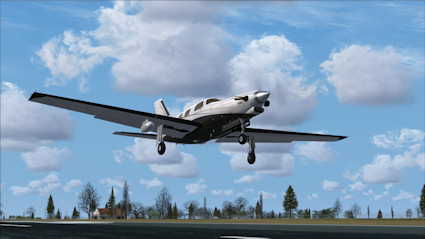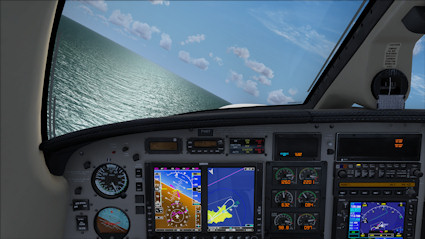Introduction
The Piper Malibu Jetprop for flight simulator X arrives courtesy
of Just Flight and renowned developer Carenado, famous for their
high quality general aviation add-ons.
It is claimed that the HD Series PA-46T Malibu Jetprop has been
designed to push the limits of what can be achieved in FSX and
deliver super high quality detail to satisfy even the most
demanding private pilot's needs. I look forward to discovering if
this bold claim is true.
The Aircraft
The PA46 is a family of light aircraft manufactured by Piper
Aircraft of the United States. The aircraft has a single engine
and has the capacity for one pilot and five passengers.
Work on the PA46 commenced in the 1970s, with the prototype first
taking to the skies on November 30 1979. The type was intended to
compete with Cessna's P210 Centurion. Like the Centurion, the
Malibu was to feature a pressurised cabin.
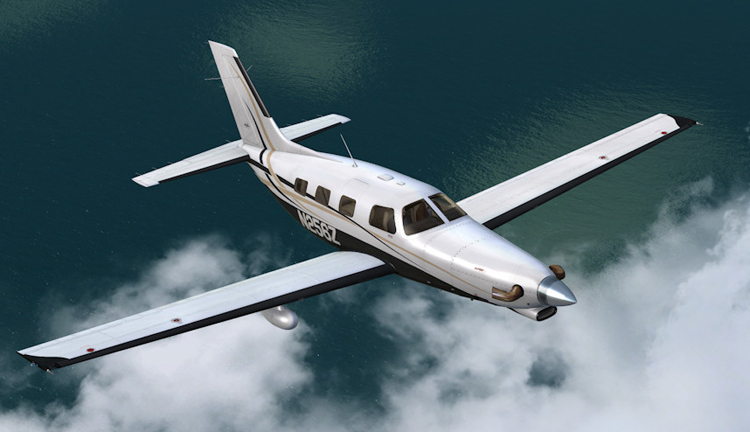
In 1994 the concept of a turbine version of the Piper Malibu
Mirage was conceived and then in 1996, JetPROP LLC was formed in
order to carry the project through the certification and marketing
process.
The conversion consists of a Piper Malibu Mirage equipped with a
Pratt & Whitney PT6A turbine engine and a Hartzell 4-blade
reversible propeller. In addition, a new dual battery system is
fitted along with rack and structure support beneath the forward
cabin seats, installation of dual heated wingtip pitot tubes,
installation of new engine instruments and the controls necessary
for the conversion.
In September 2011, the FAA certified the aircraft to land on
unpaved runways, adding increased operating flexibility without
the need for any airframe modifications, thus opening up thousands
of grass strips that weren't previously available to the Malibu.
In addition, the added power of the turbine engine transformed the
Malibu Jetprop into a true short field aircraft.
Specifications:
Engine........................................ P & W
PT6A-21
Horsepower.................................. 690 eshp -
(flat-rated 550shp)
TBO........................................... 3600 hrs
Passenger seats ............................ 6 places
Length........................................ 30’-1”
Height........................................ 11-3”
Wingspan.................................... 43’
Maximum Ramp Weight.................... 4318 lbs
Standard Empty Weight.................... 2970 lbs
Maximum Useful Load...................... 1348 lbs
Maximum Usable Fuel….................... 151gal
Payload @ Max Fuel......................... 348 lbs
Ceiling (certified)........................... 27,000 ft
Takeoff Runway (50 ft Obs.)............... 1200 ft
Landing Runway (50 ft Obs.)............... 1000 ft
Max Climb Rate (initial).................... 3000 ft/min
Time to Climb @25,000 ft.................. 15 min
High Speed Cruise (25,000 ft)............. 245-252 kts
Fuel Flow..................................... 31gph
Max VFR Range, no wind................... 1100 nm
Just Flight Download System
 On 21st December 2009, Just Flight adopted a system that no longer
required the use of complicated keycodes. I must say, I found the
download system to be excellent; it was both fast and efficient.
Just Flight is to be commended for considering their customers'
needs and adopting a system that is so user friendly.
On 21st December 2009, Just Flight adopted a system that no longer
required the use of complicated keycodes. I must say, I found the
download system to be excellent; it was both fast and efficient.
Just Flight is to be commended for considering their customers'
needs and adopting a system that is so user friendly.
The entire download process is simplicity itself. After purchase,
the customer receives an email containing a download link. The
downloaded file should be saved to a convenient location on the
customers PC. The customer simply selects "next" on the following
screen and then after agreeing to the licensing agreement the
download begins. Download time for me on my relatively slow
connection was a mere 7 minutes.
Features
• Dual screen electronic flight display G500 system
• New lighting rendering system
• Landing, taxi and strobe lights illuminate objects and
ground
• Hot Swap Reality XP integration
• New environment and ‘Fresnel’ maps
• Five HD quality liveries (2048 x 2048 textures)
• Carenado GNS530 and GNS430 installed
• Weather Radar installed
• 3D gauges
• Pop up PA46T Malibu manual with normal, emergency checklist
and performance tables
• Customisable
panel for controlling windows transparency, instrument
reflections, and static elements, such as wheel chocks and sights
props
• Real behavior compared to the real aircraft.
• Real weight and balance
• Tested by real pilots
• Realistic night lights effects on panel and cockpit
Sounds
• Original HQ digital stereo
sounds recorded directly from a real PT6A (Pratt and Whitney
Canada) engine.
Manuals
• Autopilot and AVSS PDF ·
• Carenado GNS530
Users Guide PDF ·
• Carenado GNS430 Users Guide PDF ·
• G500 Overview
PDF ·
• PA46T Emergency Procedures PDF ·
• PA46T Normal Procedures PDF
·
• PA46T Operation Tips and Reality XP integration PDF ·
• PA46T
Performance Charts PDF ·
• PA46T Reference PDF ·
• Weather Radar
Manual PDF ·
• Recommended Settings PDF
Carenado Documentation
It seems Carenado chose to take a "no nonsense" approach to the
products documentation.
Tucked away in my FSX root folder, I found a Carenado folder
containing 12 PDF documents, comprising of avionics user guides,
emergency procedures, normal procedures, and performance charts.
(There was no short cut in the programs menu). In addition, there
was a PDF containing important information for those wishing to
integrate the RealityXP Garmin 530 and 430 gauges into the
product. However, absent was the customary introductory PDF that
most developers provide and there was no tutorial included. I
found these omissions rather strange, however, with some flight
simulator add-ons' costing three times as much, I came to the
conclusion that it was perhaps because this is a relatively
inexpensive product. Even so, I believe Carenado should have at
least provided a virtual cockpit layout to enable purchasers to
locate various click spots and panel features.
Exterior modeling
As can be seen from the accompanying screenshots, the Carenado
PA46T Malibu Jetprop excels in this respect. Everywhere you look,
the claimed “super high quality detail" is evident. In fact, I
would challenge anyone to find an FSX add-on that betters the
exterior modelling of this aircraft.
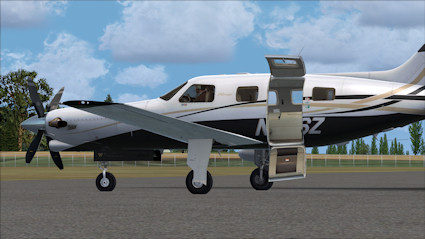 |
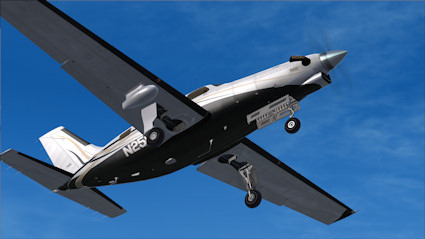 |
The only issues I could find were a stray polygon that floats alongside the aircraft and a nose wheel that sinks into the ground slightly, both issues that will no doubt be easily corrected in a future update.
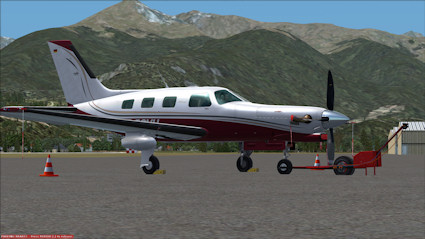 |
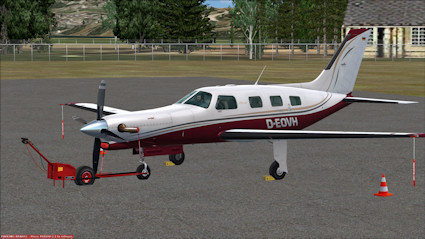 |
Realistic flap deployment animation is modelled and in addition, the door opens with the default Shift E key press.
The Malibu Jetprop includes Five HD quality liveries (2048 x 2048 textures)
Virtual Cockpit and Cabin
The PA46T Jetprop is equipped with a virtual cockpit only; there is no 2D main panel. However, Carenado's rendition of the Garmin GNS530, GNS430 and G500, are all available as 2D pop up panels. The Bendix King Weather Radar is not available as a pop up.
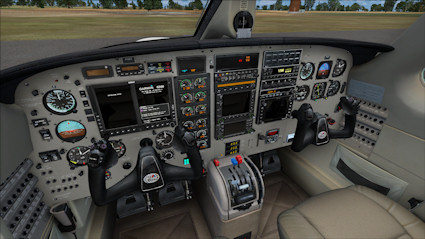 |
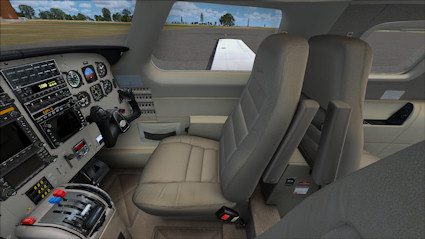 |
I must confess that until recently, I disliked virtual cockpits. However, after experiencing the gold standard in virtual cockpit design, the PMDG 737 NGX, I found myself thoroughly converted.
Carenado’s Malibu offers a very high quality virtual cockpit. However, it isn't perfect and tends to display the minor flicker that's often apparent in virtual cockpits. The issue occurs at the bottom of the G500 and is visible as a flickering white line. On my system, a higher anti-aliasing setting was the key to eliminating the flicker, but it was certainly apparent at 8XSQ, set through nVidia inspector. Nevertheless, it has to be said that the issue is minor and hardly noticed once one becomes immersed in the task of piloting the aircraft.
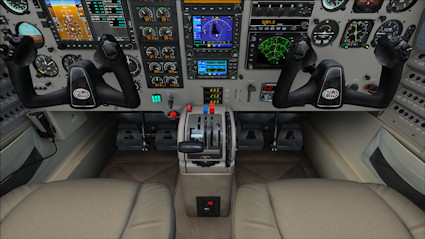 |
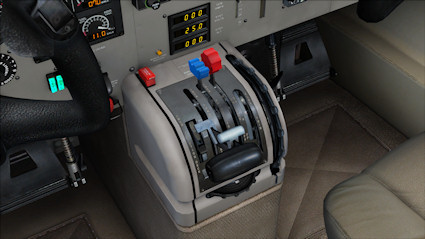 |
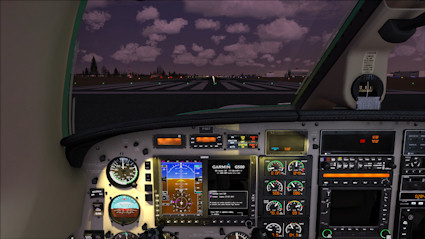 |
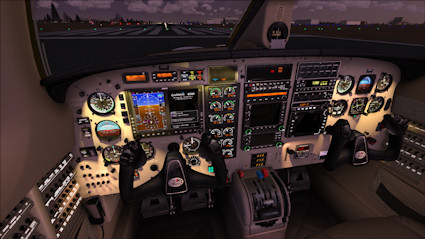 |
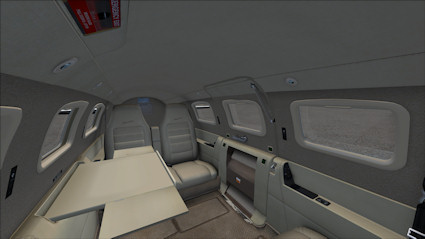 |
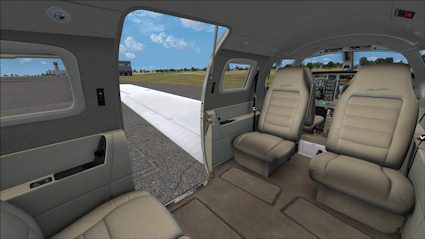 |
As can be seen from the accompanying screenshots, inside the virtual cabin the fold out table can be deployed and the doors can be opened with the latch, a very nice touch from Carenado.
Avionics
It has to be said that the G500 isn't up to the extremely high standards we have seen from some developers. I would describe the gauge as adequate rather than state of the art. However, I found that reducing the brightness of the G500 to 70% (accessed within the available menu) improved the quality of the display markedly.
I also found accessing the G500's menu's to be rather fiddly, and it took me some time to determine exactly how to reduce the display brightness. Not surprising considering there are no less than six click spots on and around the single multifunction knob, and of course it didn't help that Carenado failed to provide any guidance (in the provided documentation) as to the location of the click spots.
Note: The G500 brightness and auto zoom settings reset back to default each flight. However, there is a mod available on the unofficial Carenado support forum that permanently sets the brightness to 70% and the auto zoom feature to off.
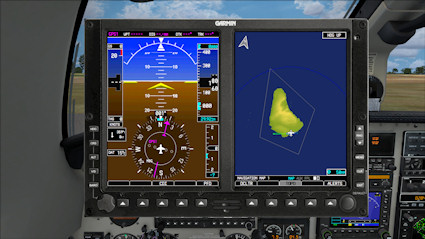 |
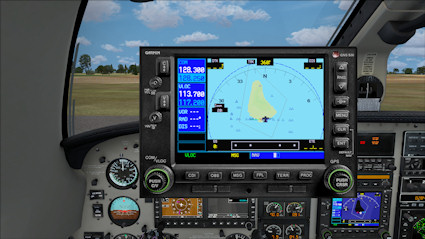 |
Carenado's rendition of the Garmin GNS430 and 530 units, I would again describe as adequate for the task rather than challenging the best out there, but the good news is that the units can be very easily replaced with the award winning RealityXP gauges.
Utilizing Carenado’s "Hot Swap" technology, it's simply a case of double clicking the provided CAR_XP.exe file and following the on screen instructions.
Both the GNS530 and G500 can be resized once popped up; the GNS430 however cannot be resized, although I found the size when popped up to be adequate.
Weather radar
There's not much to say about the weather radar, I found it of minimal use and more of an attention-grabber than a useful feature. It is perhaps unfair to blame the developer for that, as an accurate rendition of weather radar is virtually impossible due to the limitations of FSX.
Flight Dynamics
If you have the urge to either praise or criticize an add-ons flight dynamics on any flight simulation forum, there's a good chance that an infinitely wise forum member will point out that you haven't flown the real aircraft. It is of course a valid point, so the following should be regarded as a subjective opinion, an opinion not based on any real world flying experience.
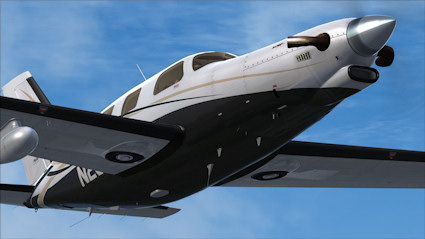 |
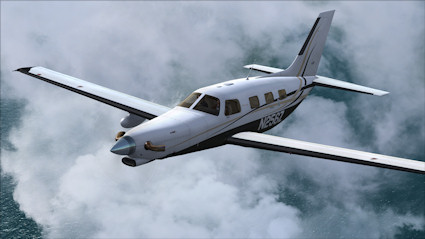 |
Modeling a turbine engine's behavior in FSX and previous incarnations of the title has always been problematic, due to the limitations imposed by the software. However, I have to say that Carenado's FDE designer Bernt Stolle seems to have done an excellent job of modeling the characteristics of the Pratt & Whitney PT6A turbine engine, in particular managing to simulate the significant amount of drag at idle. The real world counterpart is capable of descending at 4000 feet per minute at Vmo and idle and this has been accurately modeled in the Carenado Jetprop.
My first few test flights were interesting to say the least. I frequently found myself above or below the glide slope, until I became accustomed to the delayed response to my power settings. Paradoxically, I actually found this to be pleasing, as it suggested that practice would be required in order to operate the aircraft with a degree of finesse, precisely what I would expect with an accurately modeled add-on.
Autopilot
The Malibu Jetprop is equipped with an STEC autopilot, which includes heading, navigation, approach, back course, and vertical speed modes. To engage the autopilot, the multifunction AP/FD switch should first be placed in the FD position (Flight Director). After takeoff, one additional press of the switch engages the autopilot in the preselected modes.
I found the following technique to be effective in regard to operating the autopilot. Position the AP/FD switch in the FD position (one click); preselect altitude, heading, and vertical speed on the G500. On the STEC unit, select heading and vertical speed. After takeoff, click the AP/FD switch once more.
I found the performance of the Malibu Jetprop to be very good indeed, achieving 55 frames per second parked on the runway at Aspen-Pitkin County Airport (KASE). In the cruise, the aircraft was smooth in the turns and didn't display any appreciable stuttering. However, I do posses a reasonably powerful PC. For those with lesser PC's, Carenado provide the option to configure various elements. Hitting Shift 3 in the cockpit pops up a panel where you can switch on and off virtual cockpit window reflections, Instrument reflections, and static elements.
Sound
The developer claims to have included the original HQ digital stereo sounds recorded directly from a real PT6A (Pratt and Whitney Canada) engine. To be honest, the sounds I am presented with when I fire up Carenado's Malibu are so good, that I find it difficult to dispute this claim. I have never flown a Malibu Jetprop, or even had the pleasure to sit in the passenger seat. However, if one day I am so blessed, then I wouldn't be surprised in the least to hear the identical sounds.
Conclusion
I admit it, I am a fussy individual. I tend not to settle for second rate add-ons. If a flight simulator add-on doesn't meet my expectations, then it's deleted from my system with lightning speed. The Carenado Malibu Jetprop is most certainly not one of those add-ons; on the contrary, I expect it to remain in my Flight Simulator X hangar indefinitely. From the instant the virtual cockpit materialized on my screen, I was impressed, impressed with the quality of the virtual cockpit panel, and impressed with the rumble of the Pratt and Whitney PT6A power plant. And when I hit the "S" key and smoothly panned around the exterior of the aircraft, a broad smile crept across my face.
It has to be said though, the product isn't perfect, there are one or two criticisms I could make.
As mentioned previously, I was surprised to find that Carenado had omitted a virtual cockpit layout. I found myself having to spend a considerable amount of time exploring the cockpit in order to find the relevant click spots and panel features. In particular, I could find no information regarding the G500 multifunction knob click spots.

The final criticism I could make is in regard to the quality of
the G500 display. It is adequate for the task; however, it doesn't
compare with the best out there, for example the Flight1 Mustang's
G1000. It has to be pointed out though, that an adequate quality
G500 as opposed to a more graphically demanding G500 is far more
frame rate friendly, and many flight simmers with less powerful
hardware will appreciate that.
The GNS 430 and 530 can be upgraded to the RealityXP products;
however, the G500 has no high quality replacement available as far
as I know.
At this point in time, there is one optional update available on
the Carenado website that updates the FDE. Hopefully, Carenado
will include a virtual cockpit layout to aid familiarization, a
tutorial flight, and perhaps an autopilot key assignment in a
future update. If simplification of the G500 clicks pots is
feasible, that would be welcome too.
![]()
Verdict
To sum up, the Carenado Jetprop is probably the best attempt at
modeling the characteristics of a turboprop engine I have come
across, and the flight model is excellent. With a little more fine
tuning (courtesy of a service pack or two) and a little more
attention to the included documentation, Carenado has a winner.
Positive aspects of the product
•
Superb exterior modeling
•
First rate sound
•
Believable turboprop characteristics
•
Easy RealityXP integration
•
Realistic flight model
•
High quality virtual cockpit
•
Outstanding VC night lighting
Negative aspects of the product
•
No virtual cockpit layout included with documentation
•
No tutorial flight
•
G500 click spots could be improved
•
G500 menu settings not saved
Mutley's Hangar score of 9/10
![]()
Martin Wilby
Review machine Spec:
Core i7 920 DO OC to 4 Ghz | 6Gb Tri-Channel
DDR3 Ram |EVGA GTX 580 Graphics |Windows 7 64bit

